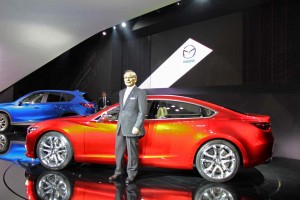A battery car without the battery?
Electric propulsion is the hot technology in the auto industry these days and might have a serious chance of transforming the cars we drive were it not for a serious problem: the high cost and other limitations of even the most advanced batteries. But with the Tokyo Motor Show introduction of the Takeri concept vehicle Mazda suggests it may have an even more high-tech solution that provides many of the advantages of battery cars without the batteries.
The Mazda Takeri itself is the latest effort by the Japanese automaker to stretch the design limits using its new Kodo design language. But one of the more interesting features is hidden under the skin. That’s the i-ELOOP system that is part of Mazda’s first in-house mild hybrid system.
It recaptures energy normally lost during braking or coasting – much like any conventional hybrid – but stores it in a device called an ultracapacitor, rather than a battery. There’s been lots of talk about using so-called “ultracaps,” but until now no one has been ready to commit to high-volume production of what you might think of as a sort of energy bottle.
Ultracapacitors won’t be able to complete replace batteries. They don’t store nearly enough energy. But they can store – and then release power incredibly fast, an advantage over sluggish batteries. They’re also less prone to deterioration than batteries after repeated use.
Short for Intelligent Energy Loop, the i-ELOOP system will be integrated into Mazda’s new Skyactiv technology, which will integrated into most of its future products, starting with the new CX-5.
The system starts out with a variable voltage alternator paired with a low-resistance, double-layer ultracapacitor and DC/DC converter. The alternator begins to recapture kinetic energy, turning it into electricity, as soon as the driver’s foot lifts off the pedal. The ultracap can be fully charged up in seconds. And when a burst of power is needed to assist on take-off or, say, during a passing maneuver, it releases that energy as fast as the car might need it.
Look to see the first use of the i-ELOOP system on Mazda vehicles starting in 2012, according to CEO Takashi Yamanouchi.
As for the Kodo language of the Takeri, watch this space. The design theme, which translates loosely as “male-ness,” should have a very strong influence on the next-generation Mazda6.

